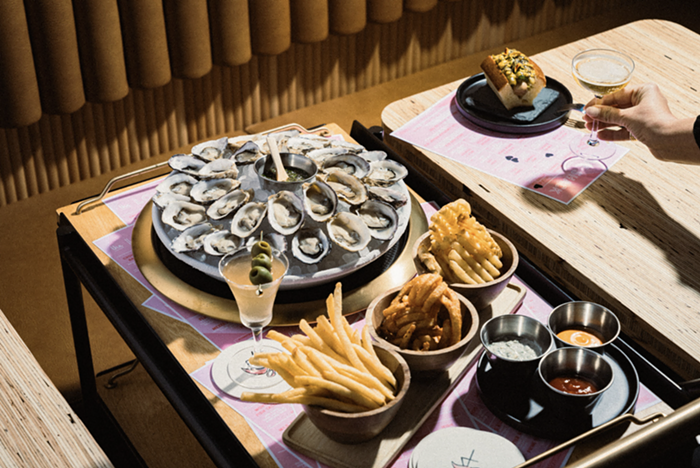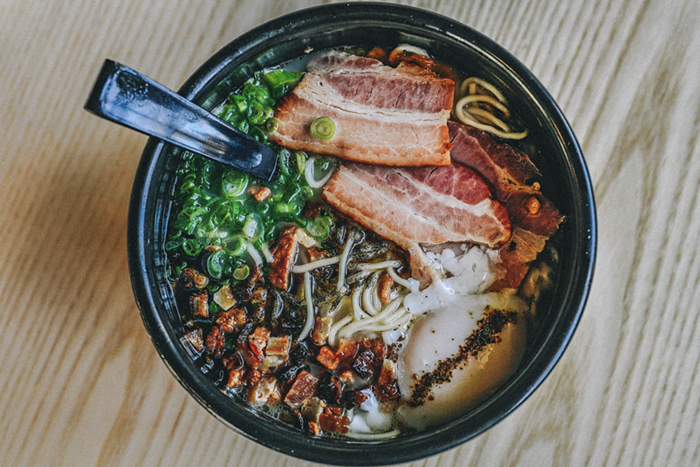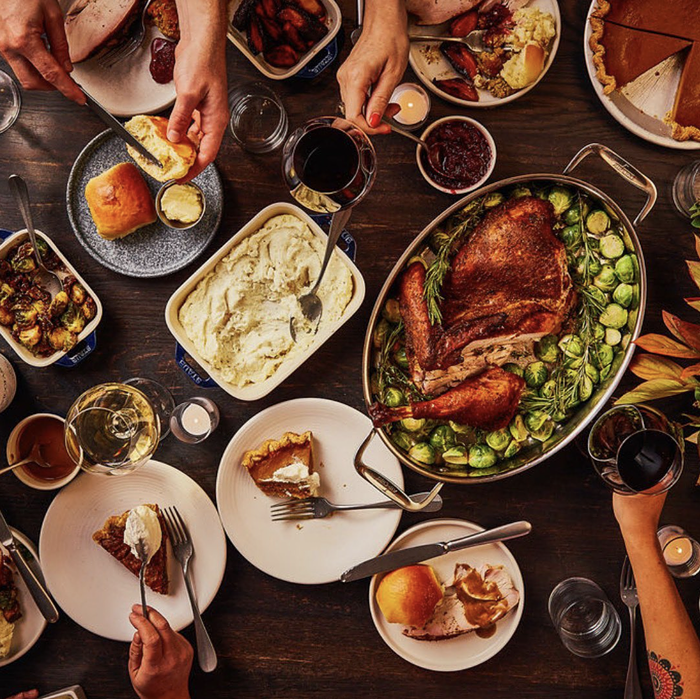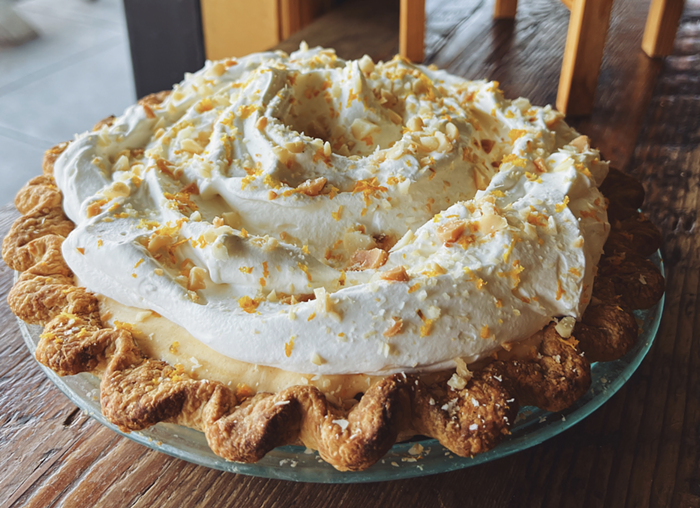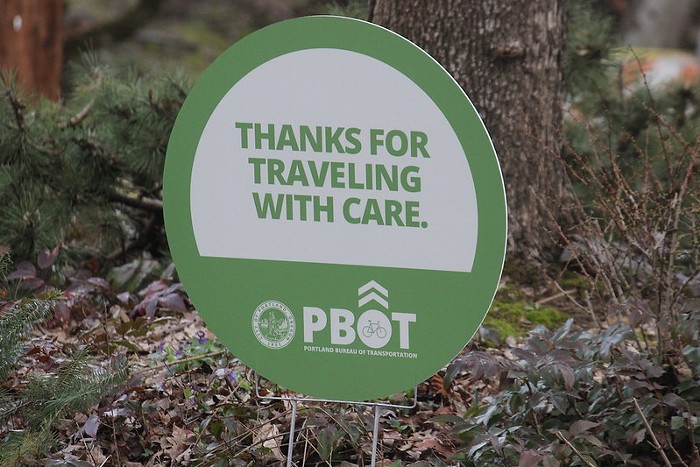A History of American Beer Geekdom
Brewpubs, Beer Fests, Bourbon Barrels, and Bestsellers: Beer’s Been Through a Lot in the Past 35 Years
Get Your Cuke On!
Oregon’s Cucumber Beers
What the Hell Beer Should I Drink?
Oregon Makes a Lot of Beers. Here’s What We Thought of Some of Them
Brews for New Avenues: Beer for a Great Cause
Portland’s Best Beer Event Is a Fundraiser to Help Houseless Youths
Portland’s Beer District
Inner Southeast Is Rich with Breweries
Beer and Cheese Are BFFs
Tips on How to Make Perfect Pairings
PORTLAND, 11:35 am, May 4, 2017—A seemingly innocuous Facebook post from Tin Bucket, a North Williams Avenue beer bar and bottle shop, started the rustling. It said, simply: “Today’s New Releases! Details in the comments. Love you all.” The post was accompanied by a photo of five bottles of beer: Two bottles from Tillamook’s de Garde Brewing and three from Jester King, a brewery based in Austin, Texas.
A quick glance down Tin Bucket’s timeline reveals a number of similar posts—new kegs coming on tap, new bottles in the cooler, and the like. To the untrained eye, the latest Facebook post may have appeared to be just another re-stocking photo, but this particular image contained something special. Within minutes, buyers began flocking to Tin Bucket, forming a line that stretched out the door. The precious that these beer Gollums coveted so dearly? A bottle of Tin Bucket’s special anniversary brew, the Broken Truck No. 3, made by the up-and-coming de Garde brewery. Within two hours of the Facebook post, all 30 cases were gone.
There were five uncommon beers in that photo, but only one sold out that Thursday. Each was a seasonal or limited release not readily available at your neighborhood 7-Eleven or Fred Meyer, and they all boasted high ratings on the beer-rating websites. Jester King doesn’t even have an official distributor in Oregon. Was the Broken Truck that much better?
The frenzy at Tin Bucket is emblematic of the current state of beer culture at its sharpest (read: geekiest) end, where rare beers of certain stripes quickly get snatched up for reasons you might not expect. You see, some of the people who seek out rarities like the Broken Truck have no intention of drinking them—they intend to trade these beers, which are highly sought after but are only available locally (and briefly, at that), for beers that are similarly highly sought-after but aren’t available here. One could make the argument that the Broken Truck’s real draw, more than its flavor or quality, is the perceived demand it commands from the online beer trading community.
In psychology, there’s a paradigm known as the Scarcity Heuristic, in which our brains place extra value on objects that could disappear or get snatched up by our to competitors. The harder it is to get something, the more value it has. You’ve probably experienced this: Think of a restaurant that has a long line of people waiting to get in the door. Your brain tells you instantly that this restaurant is desirable, and the people in line must possess information you are not privy to. You were planning to go to the place next door, but seeing the line has made you re-think your original choice.
The majority of beer drinkers may not realize it, but the same dynamic plays out in the cooler at your local beer shop every day.
HOW DID WE GET HERE?
It wasn’t always like this. Beer geekery is still a relatively new phenomenon in American life, and several cycles of beer culture had to occur to set the stage for it. Before the long dark days of macro lager domination—i.e., most of the 20th century—the United States was home to a multitude of thriving breweries, each pumping out unique beers made with recipes and techniques imported from the old country.
Portland’s own Henry Weinhard’s first opened in 1856 in what we now call the Brewery Blocks, supplying denizens of the Rose City with the German-style beers that Weinhard had learned to craft back home. The difficult logistics of shipping and refrigeration made these types of regional breweries a staple of early American life; every decent-sized city had a brewery to call their own.
All that changed in 1919, when the Abolitionists got their way and passed the Volstead Act, which prohibited the sale of alcohol nationwide. By the time the law was repealed in 1933, only a handful of the largest breweries had survived these lean times, mostly by selling soda and water. The beers that followed Prohibition had lost much of their original appeal and eventually morphed into what we now know as the industrial lager. These beers were (and still are) light, clean, refreshing, and not much else.
Following prohibition, it wasn’t until 1982—almost 50 years after the repeal of the law—that many in the Northwest had their first taste of what we now refer to as “craft” beer.
BERT GRANT AND THE BREWPUB
When Bert Grant opened Grant’s Brewery Pub in Yakima, Washington, in 1982, it was considered to be the first establishment of its kind. Its success showed that America had a newfound thirst for beers that offered discernable flavor. Fast-forward a few years, and American beer culture was already going through its first paradigm shift since the country went dry, thanks to the explosive popularity of brewpubs. Whereas before your only “choice” was among a tiny number of huge macroweisers trucked in from far-away states, you could now go to a local establishment to procure and enjoy beers made on the spot. For those weaned on macro lagers, these first local beers must have been mind-blowing. Served incredibly fresh, they could be hoppy, thick, flavorful, and malty—and best of all, you could hang out with the folks making them over a pint. The revolution was underway.
THE GREAT AMERICAN BEER FESTIVAL
As with any local endeavor, different regions of the country began arguing about whose beer was best, and the American beer drinker slowly started developing a thirst for good, interesting beers that might not be available at the local brewpub.
1982 was clearly a big year for beer in America, as it also marked the inaugural Great American Beer Festival (GABF) in Denver, Colorado, a competition to award the best beers in the country with gold, silver, and bronze medals. With it, a ranking system emerged that could quantifiably rate your local microbrewery against all the others. To this day, a gold medal at GABF can catapult a small, unknown brewery onto the national stage.
The side effect of this was that the American beer industry grew competitive, escalating into a full-on arms race to develop the stronger, hoppier, fruitier, and more adventurous beers drinkers demanded. Beer was no longer just a means to a buzz or a cold one you crack after work. For the first time in a long time, the drinking of beer became an event. The lure of a gold medal at GABF proved to be such strong incentive that breweries began styling beers specifically to compete. A significant portion of a brewery’s marketing budget could be dedicated to the expenses required to enter GABF. This pressure to make a beer that would stand out from the crowd was the perfect impetus for the trends that were about to emerge.

THE AMERICAN IPA
As indicated by the name, the now-ubiquitous India Pale Ale was not an American invention. But it didn’t come from India either, exactly: English brewers would make these ales at home for export to colonial India, brewing them with an extra measure of hops to act as preservatives during the long voyage by boat. Eventually, the flavor properties of the hops—which could be floral, citrusy, bitter, or herbal—became the draw of the IPA style. And as new American brewers discovered, their dominant hop profiles made them relatively easy to make, as the bitter hops could mask any undesired effects from the brewing process.
The style was popular from the beginning of the craft-beer era, but around the turn of the millennium, the IPA was suddenly everywhere, in increasing degrees of bitterness and strength. In the span of a few years, IPAs dominated the craft beer market, making even the largest commercial breweries take notice. Breweries complied with the demands of consumers and quickly saturated the market with a bevy of extremely hoppy and bitter beers. While new iterations come and go, the staying power of the IPA is not to be denied.
BARREL-AGED BEER
Historically, beer was aged and stored in all manner of wooden vessels, but following Prohibition, the availability, price, and ease offered by stainless steel had transformed the brewing industry. The entire beer-making process—from the brew kettle to the serving vessel—could be accomplished almost entirely using metal equipment.
But when Chicago’s Goose Island Brewing introduced Bourbon County Brand Stout in 1995, it took the brewing world by storm. The beer was a thick, strong, sugary stout, aged in used bourbon barrels to create a new flavor—one that contained notes of oak, smoke, vanilla, and (obviously) whiskey.
America’s thriving bourbon industry provided a seemingly perfect match for the burgeoning market for experimental beers. Federal standards dictate that in order for whiskey to be called bourbon, it must be aged in new, charred oak vessels. Emphasis on the word “new”—a bourbon barrel can never be re-used to make more bourbon. This created an availability of used bourbon barrels that had previously been sold off to rum or tequila distilleries; now these could be sold off to breweries, too.
In one sense, Goose Island was offering a throwback to the days before stainless steel. But there was a big difference between pre-Prohibition brewing and Goose Island’s approach: The barrel itself was the central factor in the flavor of Goose Island’s finished product, not merely a convenient means of storage. Barrel-aged beers of all kinds—not just bourbon—soon became immensely popular. Their rise also signaled a newfound adventurousness in beer making, wherein new ideas and flavors augmented traditional beer styles. This surfeit of creative brew choices coming out of American craft breweries gave rise to forums for interested beer geeks to unite and share information.
TAKING BEER ONLINE
Founded in 1996 with the rallying cry of “Respect Beer,” Beeradvocate.com was the first website dedicated to rating and discussing beers to gain traction among drinkers. Another, Ratebeer.com, followed suit; these forum-based sites provided an arena for beer geeks to talk shop and rate beers on a 1-to-5 scale, and they took their duties very seriously.
The American beer scene was about to go through another transformation. Almost overnight, vast hordes of (mostly) men fired up their Netscape browsers and began trawling the sites. Essays glorifying the unique and amazing aspects of certain beers littered the forums, alongside homebrew recipes, photos of beer, and burning philosophical questions:
“What are you drinking?”
“What is good where you are?”
“How can I get some?”
Soon forum users were furtively looking for fellow beer enthusiasts to trade beer with. The precise origins of beer trading may be a mystery, but it no doubt comes down to two geographically separated drinkers agreeing that it was a good idea to start sending each other beer through the mail.
TRADING BEER
In the space of a few years, thousands of boxes, filled to the brim with out-of-market beers, were carefully packed and loaded onto trucks. To put the explosion of beer trading into perspective, the US Postal Service estimates that the market for shipping alcohol could grow to be as high as $50 million per year. If a drinker was lucky enough to live close to a highly sought-after brewery, he or she could parlay those easily accessible suds into just about any beer in the world. All that was needed was a login to a beer website, someone on the other end to reciprocate, and some disposable income.
Just so we’re clear, it is totally, 100 percent illegal to send alcohol through the mail without a license. However, it hasn’t been heavily policed, and the USPS has even suggested that it should be legalized as a way to earn extra revenue. Traders always risk beers being confiscated and enjoyed by the fellas at the UPS shipping center, but that might be the worst-case scenario.
This wildfire of interest, focused in the chat rooms and ratings websites, was the perfect backdrop for the emergence of regional beer festivals that started cropping up all across the country. These hedonistic gatherings helped fuel the hype and demand for beers that stood out from the crowd. And to satisfy this audience, progressive and ambitious breweries continued their assault upon traditional brewing techniques.
THE RISE OF THE “FESTIVAL” BEER
You could argue that both beer fads and traditions follow market pressures and consumer demands. While English pub culture may favor low-alcohol, sessionable beers that can be downed in relatively large amounts without ruining one’s chances of making it to work the next day, the weekend crowd at a typical beer festival wants the exact opposite. Beerfest crowds want to get fucked up and drink some crazy shit.
Breweries began producing bizarre and impractical beers specifically for these festivals—beers that were so sweet and strong, they could only reasonably be consumed in a festival’s four-ounce portion. Aside from the usual tricks like barrel aging and high alcohol content, these festival beers also emphasized special ingredients. Beers with intense doses of herbs, spices, nuts, twigs, berries, and meat would catch the eye and wallet of the jaded beer geek, quickly gaining desirability even outside of festivals. American craft beers got bigger, thicker, hoppier, more barrel-aged, more alcoholic—and stupider. Eventually, things started to get a little sour.
BUT FIRST, SOME SCIENCE
Germany is arguably the country most synonymous with beer and beer culture, but its neighbor to the west, Belgium, has captivated the attention of the most rabid form of beer geek: the lambic drinker. Belgium is home to many unusual styles of beer, but lambic may be the strangest. It makes use of spontaneous fermentation techniques that result in flavors some might not even identify as particularly beery. The differences in Belgian brewing techniques and general philosophy have played a huge part in making certain Belgian beers the most sought-after in the world. German beers, while enjoyable, are best drunk quickly and close to the source.
Humans brewed for thousands of years without knowing exactly how the process worked. These proto-brewers understood the basic process of making beer and even the importance of repetition, but didn’t comprehend that the “magic” responsible for fermenting the beer was actually a living organism. Scandinavian families kept a prized brewing paddle or “yeast log” proudly displayed on the wall, ready to stir their next batch of homebrew and bring forth Odin’s blessing. Early Native Americans re-used their ceramic brewing vessels and were careful not to wash them in between batches. They all knew that something in their process was essential, and by repeating that process they were able to reproduce their good results.
Essential discoveries in the mid-19th and early 20th centuries by biologists Louis Pasteur and Hjelte Claussen were essential to moving brewing into the future. If the Manhattan Project was responsible for splitting the atom, then Pasteur and Claussen are responsible for splitting yeast.
With his microscope, Pasteur proved that fermentation was a byproduct of yeast, a living organism. He is credited with the discovery of what we now know as brewer’s yeast, Saccharomyces cerevisiae (or Sacc), which translates from Latin to “sugar fungus.” He was able to isolate the single species of yeast that could drive what was considered a good, or clean, fermentation.
Claussen, meanwhile, succeeded in isolating a different type of yeast called Brettanomyces (Brett), meaning “British fungus.” Brett is similar in many ways to Sacc, but in addition to producing alcohol, it also produces acetic acid and several unique flavor compounds. (It’s also the primary cause of what was long considered to be spoilage, an unintended sour flavor.) Historically speaking, most beer at that time was at least a little bit sour, but this was generally considered to be a necessary flaw, and was rarely thought of as a positive aspect.
For the first time in history, breweries were able to isolate their own house strains of Sacc and eliminate Brett and other contaminants from their breweries, enabling them to pump out the clean and consistent batches they desired. Thanks to improved yeast control in conjunction with the advent of refrigeration, lager beer grew to dominate much of the global beer market, pushing most of the traditional and regional breweries to either adapt or fold. The German brewers desired a process that was rigorously technical and easy to replicate.
But the lambic producers of Belgium had different traditions that went in the exact opposite direction.
FERMENTATION GOES WILD
The technique of open or wild fermentation practiced in Belgium for nearly a millennium produces a unique beer that relies on acidity or sourness as a core component of the flavor. Brett and bacteria—yes, actual bacteria—are responsible for this desired sour character.
The most notable feature of a lambic brewery is the coolship—a means of cooling and inoculation that involves pumping the hot, unfermented wort into a vaguely cake-shaped pan that’s uncovered and open to the elements. Wild yeast, both Sacc and Brett, along with wild bacteria such as Lactobacillus and Pediococcus land in the beer and, over the course of 12 to 24 hours, begin the fermentation process. The beer is then aged in oak barrels, typically used wine casks, for one to three years while the slow process of fermentation plays out.
While the basic process is always similar, wild beers made in this manner will never turn out exactly like the last batch. The variation and sense of possibility is one of the draws—a beer that is easy to replicate cannot be rare. Drawing on these Belgian techniques, Allagash Brewing, from the other Portland in Maine, became the first American brewery to attempt a totally wild fermentation in 2007. Their Coolship series of beers worked as a proof of concept, confirming that, while the technique was Belgian in origin, the wild yeasts were not.
American breweries quickly took note and began producing more Belgian-style wild ales. There are many ways to make a “sour” beer, but those made in the style of Belgian lambic often have the most character and the best flavor—and the lowest bottle counts.
Beer geeks around the world are now spoiled for choice, and with the rise of online beer trading, almost anything is attainable for those with the means. Like all commodities, different beers have different values, and like the stock market, some see their value plummet or skyrocket on the whim of the chosen few. Rare bottles are almost never traded one for one; a fellow trader may claim the rare beer in their possession is worth three of yours. Others may try to maximize trade value of a certain highly ranked beer by making outrageous demands, seeking to “win” the trade.
Rating sites suffer from a similar form of inflation, and traders in possession of a rare beer may seek to inflate its trade value by giving perfect scores to beers in their cellar. Everyone’s taste is different, but one thing not up for interpretation is availability, which is where the Scarcity Heuristic comes into play. And beer’s qualities exacerbate it: Beer is essentially a perishable commodity, and unlike most manufactured goods, a particular beer may never be made again, or may not taste as good in the next batch.
In fact, the success of a beer could easily lead to its undoing if the brewery responsible makes it too available. This year’s hype beast might become next year’s shelf turd.
THE RARE-BEER BACKLASH
When beer geeks become spoiled for choice, it usually leads to overindulgence. It’s not uncommon for beer traders to suddenly find themselves entombed by the cases and cases of traded beer stacked in their garages, closets, and basements. So what happens when you’re buying more beer than you can possibly drink?
Like any reasonable kid with unfettered access to a cookie jar, traders began to cellar or age all sorts of beer because of a fallacy that all barrel-aged beers improve with age. Sadly, it seems this is a lesson beer geeks have learned the hard way. It can be literally tough to swallow when you realize that the bourbon-barrel-aged mocha porter you’ve been storing for five years tastes like absolute shit. As beer traders progressed down the dark path of hoarding—I mean cellaring—they began seeking out beers that could stand the test of time without deteriorating.

ALL ROADS LEAD TO LAMBIC
The trajectory of beer traders is fairly predictable. They start with exotic IPAs before moving on to barrel-aged stouts, and when those start to get repetitive, a new flavor is needed. While this is debatable, the majority of stouts, porters, barley wines, and other commonly aged beers are best to drink within a year or three of purchase. Certain barrel-aged beers can survive prolonged cellaring, but it isn’t likely to significantly improve the flavor of the beer, and it may outright change the beer altogether. The ravages of time are, more often than not, unkind to your standard barrel-aged stout, and exotic beers with a flavor adjunct or a discernible barrel character can fare even worse.
Thanks to the O2-scavenging abilities of Brett, however, lambic and wild ales can be cellared for 20 years or more, often enjoying a remarkable improvement with age. This extended lifespan has made lambic the king of the cellar and has helped fuel the boom in American-made wild ales.
While American breweries have made incredible progress, they have yet to match the overall quality and flavor that a proper Belgian lambic can still offer at a fraction of the cost. When you factor in brewery startup costs, market pressures, and a desire for increased profits, some American wild ales can top $30 a bottle, while the best Belgian lambics often go for less than 10 Euro in their home country.
An argument could be made that Belgian producers are undervaluing their product. Brasserie-Brouwerij Cantillon, a traditional lambic brewery located in the heart of Belgium’s capital, Brussels, makes what is quite possibly the most sought-after beer in the world, and this level of interest has fueled an active secondary market. While a bottle of Cantillon Classic Gueze may cost 7 Euro at the brewery, you can find it for double that price just a few blocks away at any number of beer shops hoping to appeal to a tourist’s wallet.
Even beyond the standard price gouging in Brussels and beyond, a cottage industry has grown up around the demand for these beers. Multiple online businesses specialize in selling and shipping Belgian beers to almost anywhere in the world, and these are just the legal ones—an enormous black market also exists to support the unquenched demand. Cantillon, for example, has been forced to take extraordinary measures to keep the black-market forces at bay. They reserve the right to turn away visitors they identify as “mules”—people who are buying beer at the brewery price in order to sell it on the black market. They also employ a novel system of packaging where they only apply labels to a portion of a finished batch of their high-demand beers. That way they can stagger its release and avoid a rush when it first goes on sale—but you can view the unlabeled bottles at the brewery, stacked and ready, long before you can buy them. This can be frustrating for the visiting beer geek who has flown 5,000 miles and can see these special beers but is unable to purchase them, but it’s easy to see why they have taken these steps.
Belgian breweries are not alone in this regard, and American breweries have been forced to adopt similar tactics. Despite the practice being expressly prohibited by the brewery, a well-timed glance at Craigslist’s Oregon Coast section can sometimes reveal an ad seeking a “mule” to pick up bottles at Tillamook’s de Garde Brewing, and multiple breweries across the country have been forced to ban people who are paid to wait in lines.
BEER GEEKERY IS BIG BUSINESS
Craft brewers aren’t the only ones looking to get in on the rare beer craze. Most will have heard of the recent acquisitions of craft breweries by the macro breweries in their attempt to join the party. These multinational conglomerates have clearly adopted the stance that if you can’t beat them, buy them, and when Anheuser-Busch InBev purchased Chicago’s Goose Island in 2011, it sent shockwaves through the industry. As a pioneer in barrel aging, Goose Island was a mainstay of the craft beer market, and bottles of their Bourbon County Brand Stout had a dedicated following around the world. Beer buyers and traders grew concerned about the future of the craft industry and worried that their favorite beers would become shells of their former selves.
In 2010 Goose Island released a special version of Bourbon County Brand Stout called “Rare.” It was aged in impossible-to-source Pappy Van Winkle barrels, and was promised as a one-time only release, never to be sold again. A single bottle cost $40 and quickly sold out. The secondary market brought the price even higher still.
When the AB InBev-owned Goose Island announced that they would be selling Rare 2.0 in 2015, the strategy behind the acquisition was clearly evident. Doing their best to stoke demand, Goose Island offered a lottery for the chance to buy a bottle, and sold tickets to a festival where Rare would be poured for $40 a pop. The bottles themselves went for $60 apiece and were packaged with a custom glass and housed in a handsome wooden box. Early misgivings were forgotten, beer geeks ate it up, and demand for Rare was off the charts. Goose Island has not released an official figure, but some industry sources have placed the number of bottles sold in the hundreds of thousands; Goose Island did announce that 75,000 people had RSVP’d for the Rare Day lottery. Festival and draft sales aside, the total profits garnered from Rare 2015 could be in the tens of millions of dollars from this single beer. With a massive increase in production and distribution, AB InBev made their investment in Goose Island look like a very smart move.
But fast-forward to 2016 and, after the initial craze, bottles of Rare could still be found at bottle shops across the country. While many beer aficionados were willing participants in AB InBev’s sales scheme, the highly priced beer never quite lived up to its name.
RAZZLES, THE BLACK MARKET, AND BEER TODAY
The secondary market for rare beer continues to grow and evolve. Under a shadow of dubious legality, several websites enable individuals to market and sell bottles to others. Social media, with Facebook and Instagram taking the lead, has also taken on much of the role previously supplied by beer websites, as have online forums like Reddit.
One astounding method of maximizing profits is to hold a “razzle,” in which a seller offers tickets at a low cost, perhaps $5 each, that enter you into a contest to win the beer prize. The buyers can get in cheaply, and the seller can offer unlimited tickets to raise an even greater profit.
Other novel and legal means of acquiring out-of-market suds include websites that offer home delivery for beers that are out of your territory. The bourgeoning secondary market is directly related to the continued success of the craft brewing industry, and at this point it may be a truly symbiotic relationship.
The negative connotations of the black markets and overly needy fanboys may be one part of the overall scene, but there are positive aspects as well. One clear outcome of America’s health-care nightmare has been the advent of the charity razzle, where tickets are sold to raise funds for a friend or family member in need of medical assistance. And Portland’s beer event Brews for New Avenues (see pg. 20) has channeled this newly formed market into a fundraising dynamo to benefit local charity New Avenues for Youth.
While some breweries have been forced to take more aggressive steps in policing their bottle sales, having too much interest is rarely a bad thing for a business—if you asked any brewery, they would certainly choose to have problems
meeting demand rather than have problems selling. The entire Belgian lambic industry was on the verge of folding in the ’80s and ’90s before the explosion of American interest pulled it back from the brink of insolvency. And producers such as Cantillon could certainly raise their prices, but they don’t have to and they don’t want to.
Having survived the lean times, these Belgian breweries—some of which span generations—are focused on the long-term health of the industry, rather than seeking to cash out while the market is hot. This attitude differs drastically from their baby-brewery counterparts in the US, but given that the current iteration of the American beer scene is only about 30 years old, some leeway should be offered to a group that is still experiencing growing pains. Europe’s beer culture has a thousand-year head start, give or take a few centuries, and the overwhelming exuberance of the American Beer Geek makes perfect sense based on our shared history.
The rise of the beer geek and the rare beer craze has clearly benefited the everyday drinker as well. Even as the geekier collectors squirrel away their rare and exotic bottles, communities continue to rally around beer as a focal point for friendship and good times. With more styles of beer reaching more lips than ever, even casual drinkers are able to find new brews and styles they really like, and the next big beer fad could be something totally unexpected. Whatever form it takes, with new distribution options and increased competition from breweries, there has never been a better time to drink beer in America.
